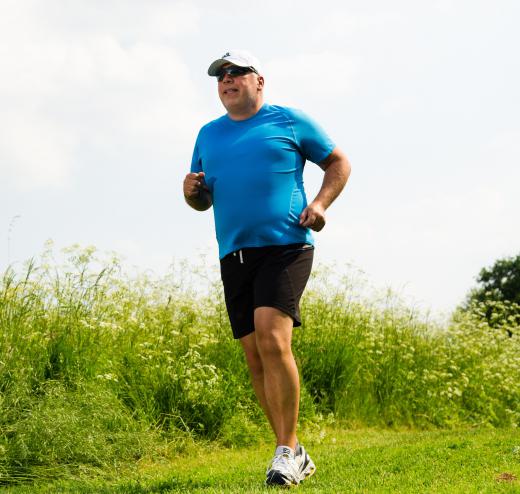A pedometer, sometimes also called a “stepometer,” is an electronic device that calculates the number of steps a person has taken. Most are relatively small and are designed to fit inside a pocket or clip onto a belt, and will sense the wearer's movements and count the steps based on hip movement. Most will then convert those steps into a measurable distance, though this usually involves calibration to the wearer’s stride length if it’s going to be accurate. People frequently wear these devices as a way of motivating themselves to walk more often, or as a means of measuring distance covered while going about ordinary day-to-day activities. There are a number of different styles and models available in most places. They can range from basic display-only devices to complicated machines that synch to smartphones and weight loss websites. The basic premise of counting steps is the same no matter the specifics, though.
How it Works

Most pedometers work by sensing vibration and the swinging motion of the hips that happens whenever a person walks or runs. This is the main reason they’re worn on or near the waist: they are actually measuring the movement that happens in the leg sockets with each step. This is normally done through a combination of electronic sensors and basic gears on the inside of the device. In most cases, calculating steps taken is pretty easy. The devices can’t usually measure intensity, however, which is to say that steps walked at a slow gait usually register the same as those jogged or even sprinted.

Many models are also able to convert steps taken into distance covered, typically in miles, kilometers, or both. There is some room for error here unless the devices are carefully calibrated to the user’s specific stride. Someone with very long legs may cover significantly more ground with a single step than would someone with much shorter legs, though an uncalibrated stepometer might show the same distance for each. This can be avoided by programming the device to the user’s exact stride length. The exact process for this varies by device, but in most cases it isn’t very difficult.
Models and Styles

The most basic pedometers are simple battery-operated boxes with little more than a display screen and an on/off switch. Some can store data from multiple days, but many are reset each time they’re turned off. Models in this category are usually quite inexpensive, and can be good choices for people who don’t need or want any sort of serious tracking.

There are many different options, though. Fancier models can store step counts from days or even weeks and years past, which can give people a good way to track their progress over time. Many modern devices can also be synched up to other technology including phones and websites. In this way, the devices can become part of a larger workout or fitness regimen, and data can be seamlessly transferred and inputted from one place to the next.
Popularity

Many health professionals say that walking is one of the best forms of exercise, and it’s also something that’s relatively easy for most people to incorporate into their daily lives. Pedometers are often the most popular with individuals who want to walk more but aren’t sure how they’ll fit it in to their lifestyles. Wearing one of these devices will count even everyday steps, like up and down the stairs or from the office to the car, and watching the numbers go up can encourage people to do things like park a bit farther away or walk down the hallway one more time in order to stay on target. These may seem like small things, but over time they can lead to better health and even weight loss.
General Usage Tips
Most experts offer three basic tips for people interested in using one of theses devices. It’s usually a good idea to begin by setting a baseline by wearing the device but not doing anything out of the ordinary. Doing this for about a week can give a person a general sense of how much walking he or she does naturally.
Then, the person should set a goal. He or she should try to increase the first week of walking activity by approximately 20%. The wearer can create a walking routine that will help reach this goal and write down the results each day, or track them in the device or online.
Finally, users are encouraged to strive for what’s known as “maximum potential.” Each week, the person should continue to add onto the goal for the number of steps he or she takes. Most fitness specialists recommend that a person try to get to between 6,000 to 10,000 steps a day in order to get the most benefit. Being realistic here is really important, though. For most people, adding just a few steps each day can improve both mental and physical health, but visible results can take months or even years to appear. The people who have the most success with these devices take them for what they are — just one tool in a larger arsenal of health and fitness resources.
